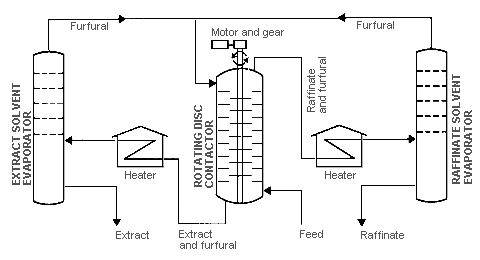Solvent treating is a widely used method of refining lubricating oils as well as a host of other refinery stocks. Since distillation (fractionation) separates petroleum products into groups only by their boiling-point ranges, impurities may remain. These include organic compounds containing sulfur, nitrogen, and oxygen; inorganic salts and dissolved metals; and soluble salts that were present in the crude feedstock. In addition, kerosene and distillates may have trace amounts of aromatics and naphthenes, and lubricating oil base-stocks may contain wax. Solvent refining processes including solvent extraction and solvent dewaxing usually remove these undesirables at intermediate refining stages or just before sending the product to storage.
The purpose of solvent extraction is to prevent corrosion, protect catalyst in subsequent processes, and improve finished products by removing unsaturated, aromatic hydrocarbons from lubricant and grease stocks. The solvent extraction process separates aromatics, naphthenes, and impurities from the product stream by dissolving or precipitation. The feedstock is first dried and then treated using a continuous countercurrent solvent treatment operation. In one type of process, the feedstock is washed with a liquid in which the substances to be removed are more soluble than in the desired resultant product. In another process, selected solvents are added to cause impurities to precipitate out of the product. In the adsorption process, highly porous solid materials collect liquid molecules on their surfaces.
The solvent is separated from the product stream by heating, evaporation, or fractionation, and residual trace amounts are subsequently removed from the raffinate by steam stripping or vacuum flashing. Electric precipitation may be used for separation of inorganic compounds. The solvent is then regenerated to be used again in the process.
The most widely used extraction solvents are phenol, furfural, and cresylic acid. Other solvents less frequently used are liquid sulfur dioxide, nitrobenzene, and 2,2′ dichloroethyl ether. The selection of specific processes and chemical agents depends on the nature of the feedstock being treated, the contaminants present, and the finished product requirements.
|
Feedstock |
From |
Process |
Typical products – to – unit |
|
Naphthas, distillates, kerosene |
Atmospheric tower |
Treating and blending |
|

Schematic of Aromatic Extraction Unit
Solvent Dewaxing
Solvent dewaxing is used to remove wax from either distillate or residual basestock at any stage in the refining process. There are several processes in use for solvent dewaxing, but all have the same general steps, which are: (1) mixing the feedstock with a solvent, (2) precipitating the wax from the mixture by chilling, and (3) recovering the solvent from the wax and dewaxed oil for recycling by distillation and steam stripping. Usually two solvents are used: toluene, which dissolves the oil and maintains fluidity at low temperatures, and methyl ethyl ketone (MEK), which dissolves little wax at low temperatures and acts as a wax precipitating agent. Other solvents that are sometimes used include benzene, methyl isobutyl ketone, propane, petroleum naphtha, ethylene dichloride, methylene chloride, and sulfur dioxide. In addition, there is a catalytic process used as an alternate to solvent dewaxing.
|
Feedstock |
From |
Process |
Typical products – to – unit |
|
Lube basestock |
Vacuum tower |
Treating |
|

Schematic of solvent dewaxing unit
Solvent treatment is essentially a closed process and, although operating pressures are relatively low, the potential exists for fire from a leak or spill contacting a source of ignition such as the drier or extraction heater. In solvent dewaxing, disruption of the vacuum will create a potential fire hazard by allowing air to enter the unit.